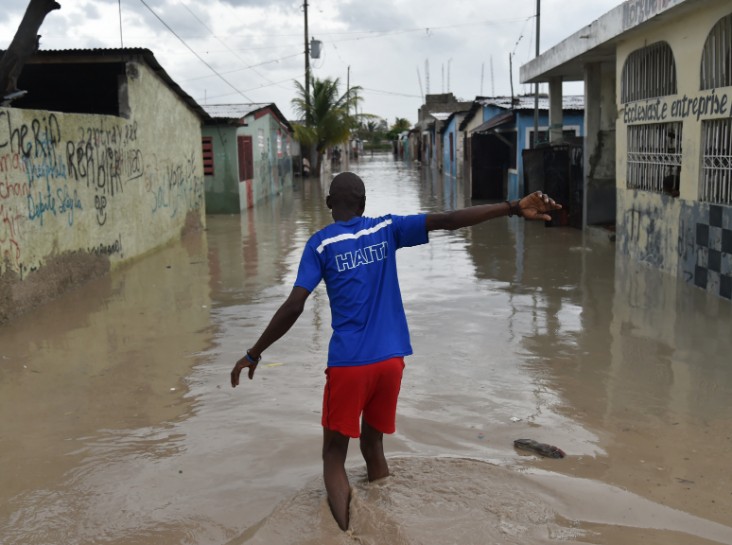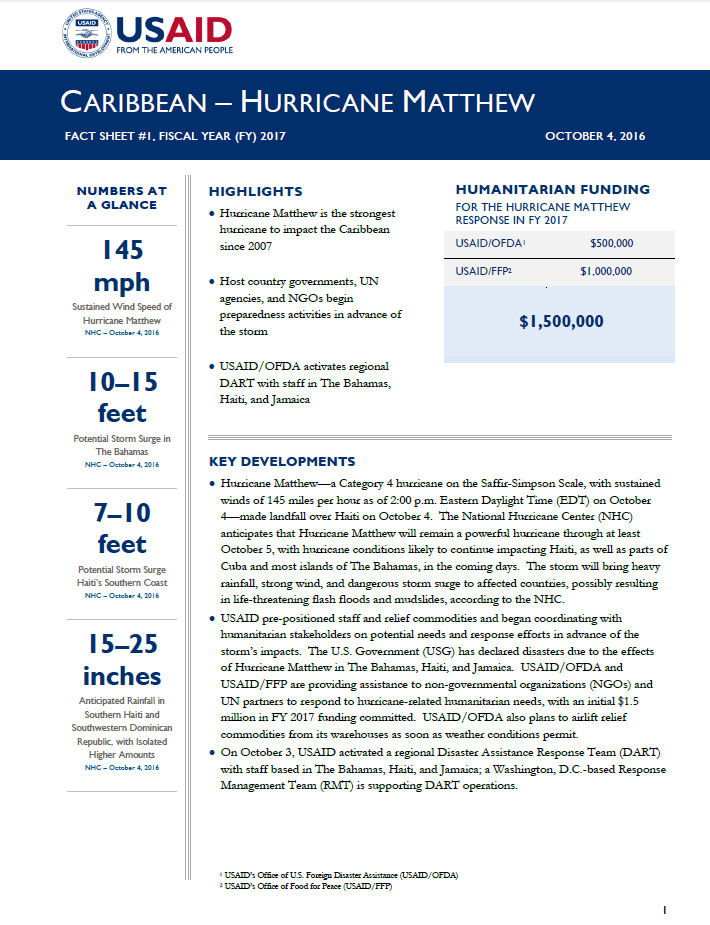
October 4, 2016
Highlights
Hurricane Matthew is the strongest hurricane to impact the Caribbean since 2007.
Host country governments, UN agencies, and NGOs begin preparedness activities in advance of the storm.
USAID/OFDA activates regional DART with staff in The Bahamas, Haiti, and Jamaica.
Key Developments
Numbers At A Glance
145 mph
10–15 feet
7–10 feet
15–25 inches
Humanitarian Funding
For the Hurricane Matthew Response
in FY 2017
| USAID/OFDA | $500,000 |
| USAID/FFP | $1,000,000 |
| TOTAL | $1,500,000 |
Hurricane Matthew—a Category 4 hurricane on the Saffir-Simpson Scale, with sustained winds of 145 miles per hour as of 2:00 p.m. Eastern Daylight Time (EDT) on October 4—made landfall over Haiti on October 4. The National Hurricane Center (NHC) anticipates that Hurricane Matthew will remain a powerful hurricane through at least October 5, with hurricane conditions likely to continue impacting Haiti, as well as parts of Cuba and most islands of The Bahamas, in the coming days. The storm will bring heavy rainfall, strong wind, and dangerous storm surge to affected countries, possibly resulting in life-threatening flash floods and mudslides, according to the NHC.
USAID pre-positioned staff and relief commodities and began coordinating with humanitarian stakeholders on potential needs and response efforts in advance of the storm’s impacts. The U.S. Government (USG) has declared disasters due to the effects of Hurricane Matthew in The Bahamas, Haiti, and Jamaica. USAID/OFDA and USAID/FFP are providing assistance to non-governmental organizations (NGOs) and UN partners to respond to hurricane-related humanitarian needs, with an initial $1.5 million in FY 2017 funding committed. USAID/OFDA also plans to airlift relief commodities from its warehouses as soon as weather conditions permit.
On October 3, USAID activated a regional Disaster Assistance Response Team (DART) with staff based in The Bahamas, Haiti, and Jamaica; a Washington, D.C.-based Response Management Team (RMT) is supporting DART operations.
HAITI
Hurricane Matthew made landfall near Les Anglais, Haiti, around 6:00 a.m. local time—or 7:00 a.m. EDT—on October 4, according to the NHC. Early reports indicate Hurricane Matthew is resulting in significant damage, including heavy wind damage and extensive flooding, in southern Haiti. The casualty figure is not yet known. Media sources note that the hurricane has destroyed houses and agricultural land and caused livestock deaths. While the storm moves northward, the NHC reported that hurricane conditions continued to affect parts of Haiti at 2:00 p.m. EDT.
The Government of Haiti (GoH) Directorate of Civil Protection (DPC) activated the national emergency operations center (EOC) on October 1, according to the Caribbean Disaster Emergency Management Agency (CDEMA). The GoH had established 1,300 emergency shelters, capable of accommodating 340,000 people, and had begun evacuations of high-risk areas as of October 2, media report. The GoH Ministry of Public Works and Transportation also pre-positioned supplies in southern departments to help clear transportation routes following the hurricane’s passage.
On October 2, U.S. Ambassador to Haiti Peter F. Mulrean issued a disaster declaration in response to the anticipated effects of Hurricane Matthew. USAID/OFDA is providing an initial $300,000 for immediate relief efforts, including $150,000 to the American Red Cross (AmCross) to support the Haitian Red Cross on logistics, emergency relief item distribution, and support to evacuation shelter management operations in departments affected by Hurricane Matthew. USAID/OFDA is also providing $150,000 to Catholic Relief Services (CRS) to support distributions of emergency relief items, including shelter materials, as well as emergency evacuation shelter management operations in Grand’Anse and Sud departments.
In advance of the storm, USAID/OFDA pre-positioned emergency relief items sufficient for 8,000 households in five warehouses in Haiti. DART personnel plan to coordinate airlifts of additional emergency relief items—including 40,000 blankets, 20,000 kitchen sets, 20,000 hygiene kits, and 3,500 rolls of plastic sheeting—from USAID/OFDA warehouses in Miami, Florida, and Pisa, Italy, to Haiti as soon as weather conditions permit.
USAID/FFP committed $1 million to NGO partner CARE to address immediate hurricane-related needs. CARE—with consortium members the UN World Food Program (WFP), Action Contre Le Faim, and World Vision—implements the multi-year, USAID-funded Kore Lavi program, which supports GoH social protection efforts by implementing a safety net program to assist 89,000 people per month with food vouchers. The additional $1 million in USAID/FFP funding will support CARE to distribute food vouchers, cash transfers, food rations, and meals for populations in shelters in hurricane-affected areas.
In addition, USAID/FFP is supporting WFP to redirect existing funding—provided by USAID/FFP in FY 2016—toward the hurricane response. WFP reports current pre-positioned food supplies in Haiti sufficient to support 300,000 people for one month.
A UN Disaster Assessment and Coordination (UNDAC) team is supporting assessments and communication in Haiti, with a planned aerial reconnaissance mission to assess the storm’s impacts on October 5, according to the UN Office for the Coordination of Humanitarian Affairs (OCHA). In addition, OCHA reports that NGO World Vision has pre-positioned emergency supplies sufficient for 15,000 households, with plans to mobilize additional relief items as needed.
USAID/OFDA is supporting a three-person Americas Support Team (AST) to provide communications support to the UNDAC team. USAID/OFDA plans to support the AST in Haiti for at least two weeks, depending on need.
JAMAICA
The Government of Jamaica (GoJ) reported activating the national EOC, as well as more than 150 emergency evacuation shelters—housing more than 3,500 people—throughout the country as of October 3 in preparation for the storm’s impacts.
On October 3, the projected path of the hurricane shifted eastward. The GoJ subsequently downgraded the national alert from a hurricane warning to a tropical storm warning—indicating expected tropical storm conditions to impact the country. The UN reported flooding in parts of southeastern Jamaica due to Hurricane Matthew as of October 4. GoJ authorities reported minimal damage in Jamaica’s southern parishes resulting from strong winds. National EOC operations scaled down to a monitoring phase, according to the GoJ.
On October 2, U.S. Chargé d’Affaires, a.i., Eric Khant issued a disaster declaration for the anticipated effects of Hurricane Matthew in Jamaica. USAID/OFDA is responding with $100,000 through the Jamaica Red Cross (JRC) to support the distribution of relief commodities. DART staff in Jamaica plan to conduct rapid assessments—in coordination with GoJ officials, JRC, and other donor and UN organizations—in eastern Jamaica.
THE BAHAMAS
As of 2:00 p.m. EDT on October 4, the NHC anticipated that Hurricane Matthew would move near or over parts of southeastern and central Bahamas between October 4 and 5, approaching northwestern Bahamas later on October 5. The NHC reports that The Bahamas will likely receive 8–12 inches of rainfall, with isolated amounts up to 15 inches, and possible storm surge of 10–15 feet.
The Government of the Commonwealth of The Bahamas (GCoB) had pre-positioned food and water, opened shelters, disseminated public alerts, and activated the national EOC, as well as EOCs in central and southern islands, as of October 3, according to USAID/OFDA staff in the country. Despite preparedness efforts, the GCoB anticipates requirements for additional relief commodities and other humanitarian assistance to address hurricane-related needs.
On October 4, U.S. Chargé d’Affaires, a.i., Lisa A. Johnson issued a disaster declaration in response to the anticipated effects of Hurricane Matthew in The Bahamas. In response, USAID/OFDA is providing an initial $100,000 to the Bahamas Red Cross (BRC) to respond to the anticipated needs of hurricane-affected populations. USAID/OFDA also has DART staff in the country supporting the GCoB and other relief actors to identify needs and coordinate response efforts.
OTHER COUNTRIES LIKELY TO EXPERIENCE HURRICANE EFFECTS
The NHC anticipated that Hurricane Matthew could result in hurricane conditions in eastern Cuba and tropical storm conditions in Turks and Caicos on October 4. Tropical storm conditions continued to affect the Dominican Republic as of 2:00 p.m. EDT. Rainfall will likely result in life-threatening flash floods and mudslides in eastern Cuba and southwestern Dominican Republic, according to the NHC, while Cuba’s southern coast may experience storm surge of 7–11 feet.
The Government of Cuba (GoC) had begun clearing drainage ditches and pre-positioning food supplies and construction materials as of October 2, according to OCHA. The Office of the UN Resident Coordinator in Cuba reported that heavy storm surge began affecting Cuba’s southern shores on October 3. The GoC had evacuated approximately 317,000 people as of October 3, the UN reports.
According to the UN Children’s Fund (UNICEF), authorities in the Dominican Republic placed armed forces on standby, began evacuation procedures, and prepared 800 evacuation shelters in advance of the hurricane.
As of October 4, the governments of Cuba and the Dominican Republic have not requested international assistance.
OTHER HUMANITARIAN ASSISTANCE
UN agencies, international NGOs, and donors continue to monitor the impacts of Hurricane Matthew and ensure response readiness. Humanitarian organizations pre-positioned staff and emergency relief commodities in countries likely to experience significant hurricane effects. In addition, multiple humanitarian agencies maintain supplies in the UN Humanitarian Response Depot in Panama and are prepared to distribute these supplies to hurricane-affected populations, according to OCHA.
On October 4, the European Commission announced an initial commitment of €255,000—approximately $286,300—to address urgent shelter, health, and water, sanitation, and hygiene (WASH) needs resulting from the hurricane in Haiti.
CONTEXT
Hurricane Matthew is the strongest hurricane to affect the Caribbean since 2007, making landfall in Haiti on October 3 as a Category 4 storm on the Saffir-Simpson Hurricane Scale before moving toward Cuba and The Bahamas. Hurricane Matthew also brought tropical storm conditions to the Dominican Republic and Jamaica.
On October 2, U.S. Ambassador to Haiti Peter F. Mulrean and U.S. Chargé d’Affaires, a.i., for Jamaica Eric Khant issued disaster declarations in response to the anticipated effects of Hurricane Matthew in Haiti and Jamaica, respectively. U.S. Chargé d’Affaires, a.i., Lisa A. Johnson issued a disaster declaration in response to the anticipated effects of Hurricane Matthew in The Bahamas on October 3.
USAID activated a regional DART on October 3 with staff in The Bahamas, Haiti, and Jamaica. In addition, USAID stood up a Washington, D.C.-based RMT to coordinate the regional humanitarian response.









Comment
Make a general inquiry or suggest an improvement.